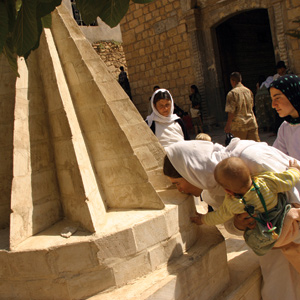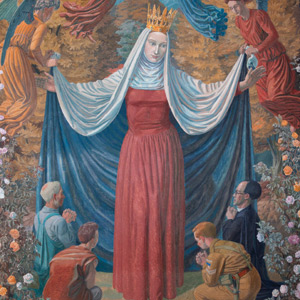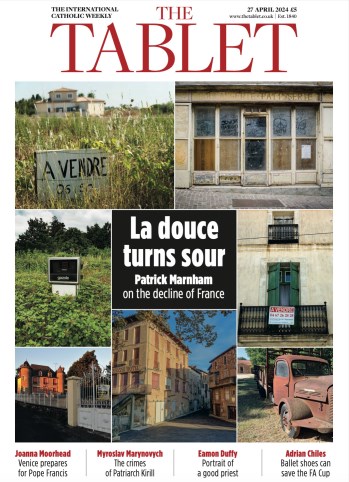In 1934, to mark the rebuilding of Campion Hall in Oxford by Sir Edwin Lutyens, Evelyn Waugh decided to write a life of Edmund Campion. The Jesuit college’s new master, Fr Martin D’Arcy, had been Waugh’s spiritual director when he was received into the Church four years before, and in gratitude Waugh donated the royalties from the book to pay for mural decorations in the new Lady Chapel.
D’Arcy was a luminary of the Catholic revival and was an avid collector whose artistic legacy to the college is still much in evidence, from the seventeenth-century Spanish carving of St Ignatius and Companions in the hall to The Veil of Veronica by Francis Bacon’s teacher Roy de Maistre on the landing.
Convinced of “the vast importance beauty does and should play in the Catholic faith”, D’Arcy was on a mission to correct what he felt was an unfair perception of the Jesuits as lacking in artistic taste, and hoped the Lady Chapel murals might contribute. But who could paint them?
The Catholic Frank Brangwyn had provided the lithographic Stations of the Cross for the Main Chapel. For the Lady Chapel, D’Arcy consulted his friend John Rothenstein, director of the Tate Gallery, who recommended Stanley Spencer on the strength of his celebrated mural cycle at Burghclere. First impressions of Spencer were not good. The eccentric artist, “so diminutive as to be almost a dwarf”, arrived at Campion Hall “in labourers’ clothes with a dusty satchel containing all his belongings”. But things went well enough until Spencer started submitting models with figures of Christ that, to D’Arcy’s eyes, seemed like “gross distortions, hideous-looking barrels”. D’Arcy went back to Rothenstein, whose father Sir William, a former principal of the Royal College of Art, recommended an ex-student with several murals already to his credit.
Charles Mahoney (1903–68) was an instant hit. D’Arcy was struck by his “wonderful sense of colour” and his Irish name seemed propitious, until it transpired that he was not a Catholic. Mahoney was an atheist, a committed socialist and a keen botanist, co-author and illustrator with Evelyn Dunbar of a recently reissued florilegium titled Gardeners’ Choice. But he was also a gifted iconographer with an innovative approach to traditional subjects, demonstrated while he was still a student in a Rest on the Flight into Egypt (1923) set in a corrugated iron shelter.
In technical terms, he was thorough to a fault. Each of his mural designs went through the approved Renaissance stages of figure sketch, study – often more than one – and life-size cartoon before being transferred to canvas fixed to the wall. This meant painting in situ, and as he could only work during spring and summer holidays from his teaching job at the Royal College – and he insisted on painting in natural light in a space with only a small east window – progress was painfully slow. The project occupied him for 10 years from 1942–52, during which time his already weak health deteriorated to a point at which he could no longer support a palette. Three panels – The Dormition on the west wall and two musician angels flanking the altar on the east – have been left in their original grisaille underpainting. As it was never completed, the mural cycle was never officially launched, which partly explains how Mahoney’s masterpiece remained such a well-kept secret.
Today, the unfinished grisaille panels serve to highlight the brilliance of Mahoney’s palette, setting off reds and blues against a verdant carpet of what the poet Marvell called an “amorous” green. Coming face to face at the chapel entrance with Our Lady of Mercy, embowered in roses and overhung by russet-leaved oaks, you could be walking into an autumnal garden. The three main murals in the arched recesses on the north and south walls reflect different seasons: The Coronation of the Virgin sharing the south wall with Our Lady of Mercy is set in summer, with a wintry Adoration of the Shepherds opposite. On either side of the sacristy door on the west wall are two scenes from the life of the Virgin – The Birth of the Virgin and The Visitation on the left, The Betrothal of Mary and Joseph and The Dormition on the right – with The Flight into Egypt filling the lunette above.
Into the narrow spaces flanking the window recess on the altar wall the artist has ingeniously squeezed an Annunciation in an Allotment, with the angel Gabriel on the left and Mary on the right, linked by a strip of earth planted with Christmas roses, auriculas, hyacinths and forget-me-nots. Below that, immediately above the altar, is a more conventional piece of iconography illustrating some of Mary’s titles in the Litany of Loreto, with a hortus conclusus at its centre. The whole chapel is in fact conceived as an enclosed garden, with a vine-covered wall encircling the vaulting and its canopy of blue sky and puffy white clouds.
After an urban upbringing in Lambeth, south London, Mahoney developed a passion for plants in adulthood that almost amounted to religious conviction. In his thirties he bought a sixteenth-century cottage in Wrotham, Kent and cultivated the sort of old-fashioned plants dismissed as weeds by most gardeners of the day but prized by Mahoney as lilies of the field. He was inspired by the democratising example of the Victorian gardening writer James Shirley Hibberd, who challenged the landed gentry’s dominance of gardening by showing how the art could flourish in suburbia. Mahoney’s friend Bernard Dunstan RA remembers Wrotham as “a village back-garden of Eden, in which sunflowers, sheds, weeds, cabbages and brick walls were treated with love and equal respect, and took their places naturally in his mural designs. Human figures are often dwarfed by sunflowers.” It’s interesting to note that in an early study for The Visitation in a cottage garden, Mary competes for our attention with a bank of giant sunflowers and a profusion of daisies that are omitted from the finished mural – along with Mary’s sun hat – perhaps on D’Arcy’s advice.
But the murals are full of other contemporary details. In The Adoration, two of the shepherds and Joseph wear sensible winter overcoats and wellington boots, and the scene is enclosed by a perfectly painted picket fence. Two little girls kneel with their backs towards us in the foreground, on a level with the chapel floor, drawing us into the scene like donors in a Renaissance altarpiece. There’s a pair of similar children in a preparatory study for The Adoration which, interestingly, features kings rather than shepherds. The figures in this version are traditionally dressed in sharply contrasting reds and blues, lit by a crisp, wintry light that falls from outside the picture. In the final Adoration, with the shepherds in their woollen overcoats and wellies, the colours are warmer and a softer light is diffused from two sources within the picture: a heavenly beam crossing the sky with an angel in its path and an ethereal radiance emanating from the mother and child, bathing the faces of all around in a gentle glow.
I suspect that shepherds suited the socialist Mahoney better than kings – pomp and ceremony left him cold. His peculiar genius was for bringing a subject up to date and down to earth without sacrificing the sense of the sacred. In The Coronation, a stripy awning does for the baldacchino under which a white-robed Christ crowns his kneeling mother in a touching replay of the Annunciation. Gone is the usual heavenly throng of saints and angels; this is an intimate meeting in a back- garden of Eden between a mother and son, witnessed by a select group of attendant angels and two human spectators. There’s a mysterious woman flanked by a pair of angels watching from behind the garden wall and a little girl in the foreground with roses in her lap. Who are these mystery figures? I like to think they’re the artist’s wife and daughter, who appears as the infant Mary in The Birth of the Virgin. Other figures in the murals are more identifiable. The suppliants sheltering under Our Lady of Mercy’s veil, held aloft by angels as in Zurbarán’s Virgin of Las Cuevas, include the college handyman in his dungarees and the Jesuit Fr Vincent Turner, Mahoney’s friend. Other members of the community shown gathered around the quilted bed in The Dormition include Fathers D’Arcy, Martindale and Corbishley, with the architect Lutyens and the hall’s carpenter in his overalls.
The mix of contemporary and Renaissance figures in domestic settings is a recipe Mahoney uses with far less awkwardness than Spencer. A sprinkling of autobiography is inevitable in any truly felt figurative work of art and, in this gem of a chapel, Mahoney gets the mix just right. He is simply updating scenarios that were contemporary for Renaissance audiences, to those appropriate for the England of his day – hence the tatted rug, diamond-patterned quilt and bar of carbolic soap in The Birth of the Virgin, set in a cottage interior furnished with just the sort of “solid, second-hand furniture” Mahoney’s daughter Elizabeth Bulkeley remembers from the family home. It was only in the treatment of vegetation that his enthusiasm was liable to run away with him. Her father’s art, says Bulkeley, was a “celebration of the beauty that lies in ordinary back gardens, and the place that we occupy in the natural world. Humans and plants blend together, the figures always subordinate to the surrounding plants.”
But the figures dominate in his beautiful Lady Chapel, an act of genuflection by a committed nature-worshipper who “for all his very different ideas and beliefs”, says Dunstan, “was not too difficult to imagine … in a different age, in a monk’s or abbot’s habit”.
The Lady Chapel Restoration Fund is raising money for preservation work on Mahoney’s murals. For information, email master@campion.ox.ac.uk or call 01865 286100.
17 December 2015, The Tablet
Secret garden
Devotional art
La douce turns sour
 Loading ...
Loading ...
Get Instant Access
Subscribe to The Tablet for just £7.99
Subscribe today to take advantage of our introductory offers and enjoy 30 days' access for just £7.99





What do you think?
You can post as a subscriber user...
User Comments (1)
When I read this article on Lady Chapel at Campion Hall, Oxford, I immediately thought of you. I'm sure you've seen the Chapel.
I hope the year is off to a good start for you.
Kevin joins me in sending you our best wishes.
Sheila Starr